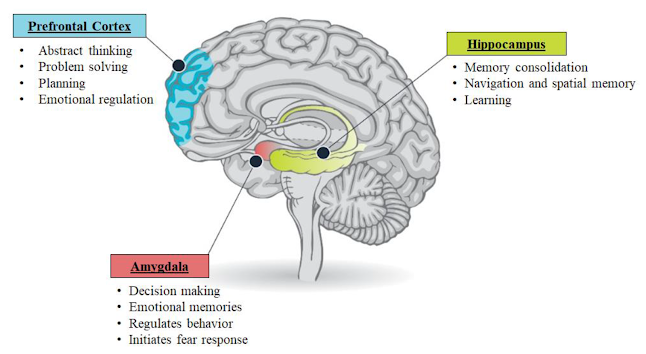Factors Affecting Neuroplasticity – Some neuroscientists working on awareness have suggested that spiritual serenity, music and games can ca...
Factors Affecting Neuroplasticity – Some neuroscientists working on awareness have suggested that spiritual serenity, music and games can cause physical changes in the brain. For example, factors such as "Awareness" or "music" or games can change brain neuroplasticity.
From where?
Our brain is effectively restructured, especially during spiritual states that we call inner peace or serenity, or by constantly occupying the mind and thinking deeply.
As our emotions and thoughts transform towards a more pleasant outlook, your brain transforms as well. The more peace of mind therapy changes, the more the brain responds to it; looks at daily life more positively with the same sense of calm, compassion and awareness.
The more carefully we live and the more we engage in spiritual activities, the more our brain defines this last state as our default state and begins to be compatible with it. This is why mindfulness exercises have a great impact on regular practitioners, even outside of special practice times. This is for those who teach their brains to be careful, calm and peaceful all day long.
It is significant in that it shows that in all religions, the neuroplasticity of those who stay alone with the Creator and realize their own existential awareness is stronger and that its effect can last throughout the day.
Promote Neuroplasticity with Spiritual Calmness and Inner Peace
Factors Affecting Neuroplasticity – There is an important connection between spiritual serenity and neuroplasticity. In particular, the neuroplasticity brought by the mindfulness mindset promotes inner peace and has a positive effect on the brain.
Some areas of the brain actually grow larger after meditation, such as the fight-or-flight response system in the hippocampus and amygdala.
How Does Music Change the Brain?
Factors Affecting Neuroplasticity – Music is not just music. Listening to music isn't just a fun way to pass the time or influence our mood and energy levels; Music can also be an effective way to make structural and functional changes in the brain.
Essentially, it shows that, whether in music majors or simply music listeners, music can help enhance the brain's natural neuroplasticity, enhancing numerous abilities and cognitive skills.
A 2010 study found that those trained as musicians showed several differences in brain structure and connectivity compared to non-musicians. Some of the study results include:
- The front part of the corpus collosum, which is the thick part of the brain that connects the two hemispheres, is larger in musicians, especially those who started their education at a young age.
- The right motor cortex of right-handed musicians, especially those who start music education at a young age, is larger than the motor cortex of non-right-handed musicians.
- The cerebellar volume of male musicians is larger than that of non-musician males.
- The volume of gray matter in the motor, auditory and visual-spatial cerebral areas is greater in musicians than in non-musicians.
- Musicians who started practicing their art at an early age have more structured “right posterior internal capsules” than non-musicians.
- Musicians have higher gray and white matter density in the left primary sensorimotor cortex and right cerebellum; has higher white matter integrity in the right posterior internal capsule.
- Pianists have greater cortical representation of piano tones.
- Musicians have enhanced responsiveness to innovations in the anterior left hippocampus.
- Musicians may show earlier and greater auditory and audiovisual responses to discursive and musical stimuli.
Do Online Games and Apps Really Work?
Factors Affecting Neuroplasticity – Harnessing the power of neuroplasticity; There are many games and apps designed to improve your memory, processing speed, and problem-solving skills.
Unfortunately, in general, these games and apps are not based on scientific experiments. In summary, scientists say the following about brain-developing games:
There is no scientific evidence that brainteasers reduce cognitive decline or stop cognitive development. Of course, no type of game promises a magic cure for the brain; However, the evidence obtained to date; It shows that cognitive health in old age can also be supported with games.
In other words, there is no harm in playing these games, on the contrary, there is evidence that establishing healthy habits and exercising regularly, learning and trying new things have a much greater effect on the brain.
TED Talks and YouTube Videos on Neuroplasticity
Factors Affecting Neuroplasticity – For a quick lesson on neuroplasticity or to learn more, the TED talks and short lectures on the subject provided below may be helpful.
9 Recommended Books on Neuroplasticity
Factors Affecting Neuroplasticity – If you want to learn more about neuroplasticity and have more than 20 minutes to spare, you can like and order one of these books on the subject:
- The Brain's Way of Healing: Remarkable Discoveries and Recoveries from the Frontiers of Neuroplasticity by Norman Doidge ( Amazon )
- Neuroplasticity (MIT Press Essential Knowledge Series) by Moheb Costandi ( Amazon )
- Switch on Your Brain: The Key to Peak Happiness, Thinking, and Health by Dr. Caroline Leaf ( Amazon )
- The Power of Neuroplasticity by Shad Helmstetter ( Amazon )
- The Stress-Proof Brain: Master Your Emotional Response to Stress Using Mindfulness & Neuroplasticity by Melanie Greenberg ( Amazon )
- The Brain That Changes Itself: Stories of Personal Triumph from the Frontiers of Brain Science by Norman Doidge ( Amazon )
- My Stroke of Insight: A Brain Scientist's Personal Journey by Jill Bolte Taylor ( Amazon )
- The Mind and the Brain: Neuroplasticity and the Power of Mental Force by Jeffrey M. Schwartz and Sharon Begley ( Amazon )
- Breaking the Habit of Being Yourself: How to Lose Your Mind and Create a New One by Dr. Joe Dispenza ( Amazon )
21 Quotes About Neuroplasticity
In this last section, you can read 11 interesting, interesting and sometimes entertaining quotes about neuroplasticity, as well as beautiful quotes from the e-book “The Sharp Brains Guide to Brain Fitness”.
***
“Neuroplasticity means that emotions such as happiness and compassion, as well as skills such as playing football and basketball or mastering a musical instrument, can be learned through repetition, and that such activities and practices change the orientation of brain areas.”
Andrew Weil
***
“Because of the power of neuroplasticity, you can actually reframe your world and be more objective by rewiring your brain. You must have the power to see things as they are so that you can respond thoughtfully, deliberately, and effectively to whatever you experience.”
Elizabeth Thornton
***
“Any man, if he wishes, can be the sculptor of his own brain.”
***
“Meditation invites what is known in neuroscience as neuroplasticity; “This is when old nerve cells relax or connect in the brain to make room for new ones to emerge.”
Craig Krishna
***
“Everything related to human education should be re-examined in the light of neuroplasticity.”
Norman Doidge
***
“Neurons that fire together wire together.”
Donald O. Hebb
***
“The brain is a flexible and adaptable organ. “All Neuroplasticities allow our brains to rewire themselves so that they can reconfigure themselves, and ultimately we are neuroplastic beings with the ability to heal and adapt.”
Douglas Rushkoff
***
“Our brain renews itself throughout life to a degree never thought possible before. ”
Michael S. Gazzaniga
***
Our minds have an incredible capacity to change the strength of connections between neurons, reconnecting them and creating entirely new pathways. However, how helpless is a computer that has the potential to crash and cannot produce new hardware, even though it is likened to a brain?
Susannah Cahalan
***
“… Most planned training has an effect on the brain and cognition, but music education has certain effects that other forms of education do not. The enhancing effects of music education, which are the result of cognitive and neuroplastic processes, such as making auditory and sound discriminations, using bimanual (two-handed) fingers, transforming visual information into motor activity, memorizing long musical pieces, learning musical structures and rules, stem from a combination of skills required by music study. ”
(Rodrigues, Loureiro and Caramelli, 2010, p. 284).
***
“Just as a new path cannot be opened on earth with a single step, a new path cannot be opened in the mind with a single thought. We walk again and again to make a deep physical path. “To make a deep mental path, we must think over and over again about the types of thoughts we want to dominate our lives.”
Wilfred Arlan Peterson
***
I would also like to add the “Top 10 Quotes on Neuroplasticity and Neurogenesis across the Lifespan”, excerpted from the book “The Sharp Brains Guide to Brain Fitness” (Kindle version is available as an e-book on amazon.com):
“Neuroplasticity refers to the brain's capacity to change and restructure itself throughout life in response to the stimulation of learning and experience. “Neurogenesis is the ability to form new neurons and connections between neurons throughout life.”
“…the best defenses against chronic stress are physical exercise, relaxation, self-empowerment, and developing social networks.”
“Learning through neuroplasticity increases connections between neurons, increases cellular metabolism, and increases the production of nerve growth factor, a substance produced by the body to help maintain and repair neurons.”
“There is not a single ‘attention,’ but three distinct functions of attention: stimulation, orientation, and executive attention.”
“Fear of failure, fear of not appearing smart, is a significant barrier to learning that I see all too often, especially in people who want to protect their perceived reputation to the point of not allowing them to try new learning cycles.”
“Emotion is the system that tells us how important something is. Attention focuses us on important things and distracts us from unimportant things. Cognition tells us what to do about it. Cognitive skills are whatever it takes to do those things.”
“As little as three hours per week has been shown to halt and even reverse brain atrophy (shrinkage) that begins in a person's forties, especially in areas responsible for memory and higher cognition. “Exercise increases the volume of the brain's gray matter (the actual neurons) and white matter (the connections between neurons).”
“Evidence of neuroplasticity has mostly been observed in the brains of individuals specializing in a particular skill. From where? Because when we specialize in a particular field, changes in learning occur to a great extent. "The areas of the brain that support the skills at which a person specializes change over time."
“Current recommendations suggest that a brain-healthy lifestyle should include at least a balanced diet, stress management, physical exercise and brain exercise.”
“Maintaining emotional connections is also important. “Not only with ourselves, but also with our family and friends, to have self-confidence and self-esteem.” Sleep and general health conditions are other important factors. “Here we focus on the four pillars of brain health: Balanced diet, Stress management, Physical exercise, Mental stimulation.”
Conclusion: Come Restructure Your Brain!
Factors Affecting Neuroplasticity – I hope you enjoyed this very short journey into neuroplasticity! As you can see in this quick journey, I have tried to explain to you a very broad and complex subject, with new discoveries every day. However, what we say is nothing compared to what we do not say.
If you want to learn more, please check out the books, videos, and other resources mentioned above. I think the study of neuroplasticity is just kind of just getting started, so it's great timing for you to get busy.
As the title states, it's never too late to start. Our brain is “plastic” and can be restructured at any age.

















.jpg)

No comments